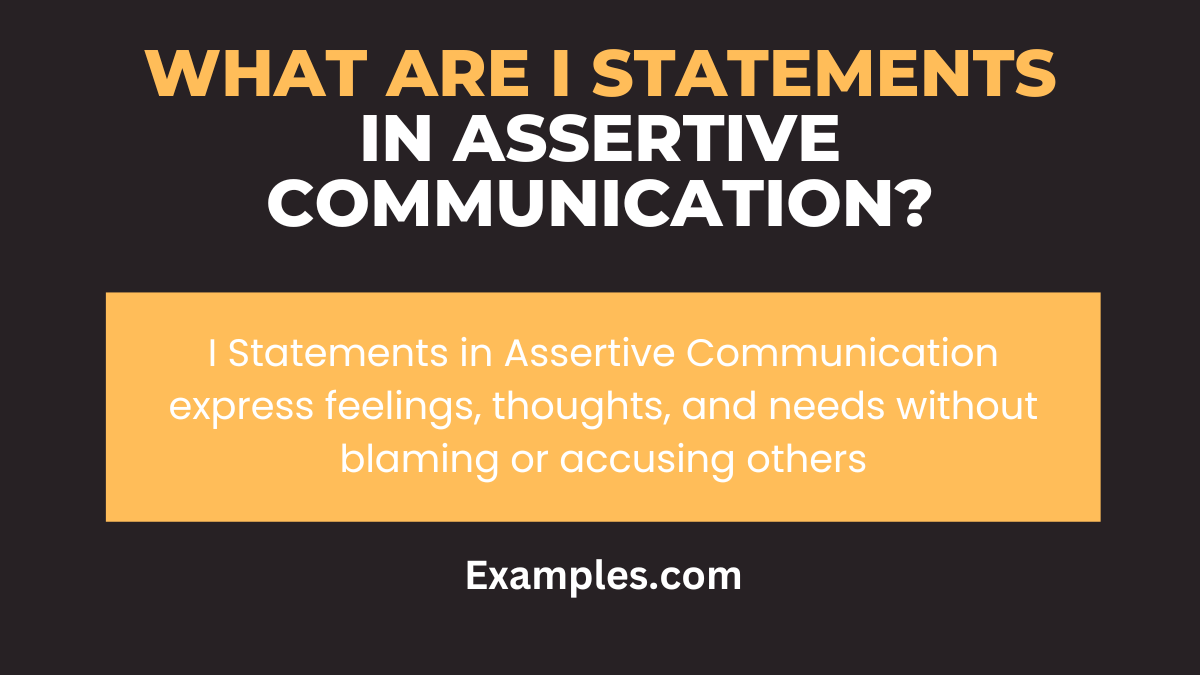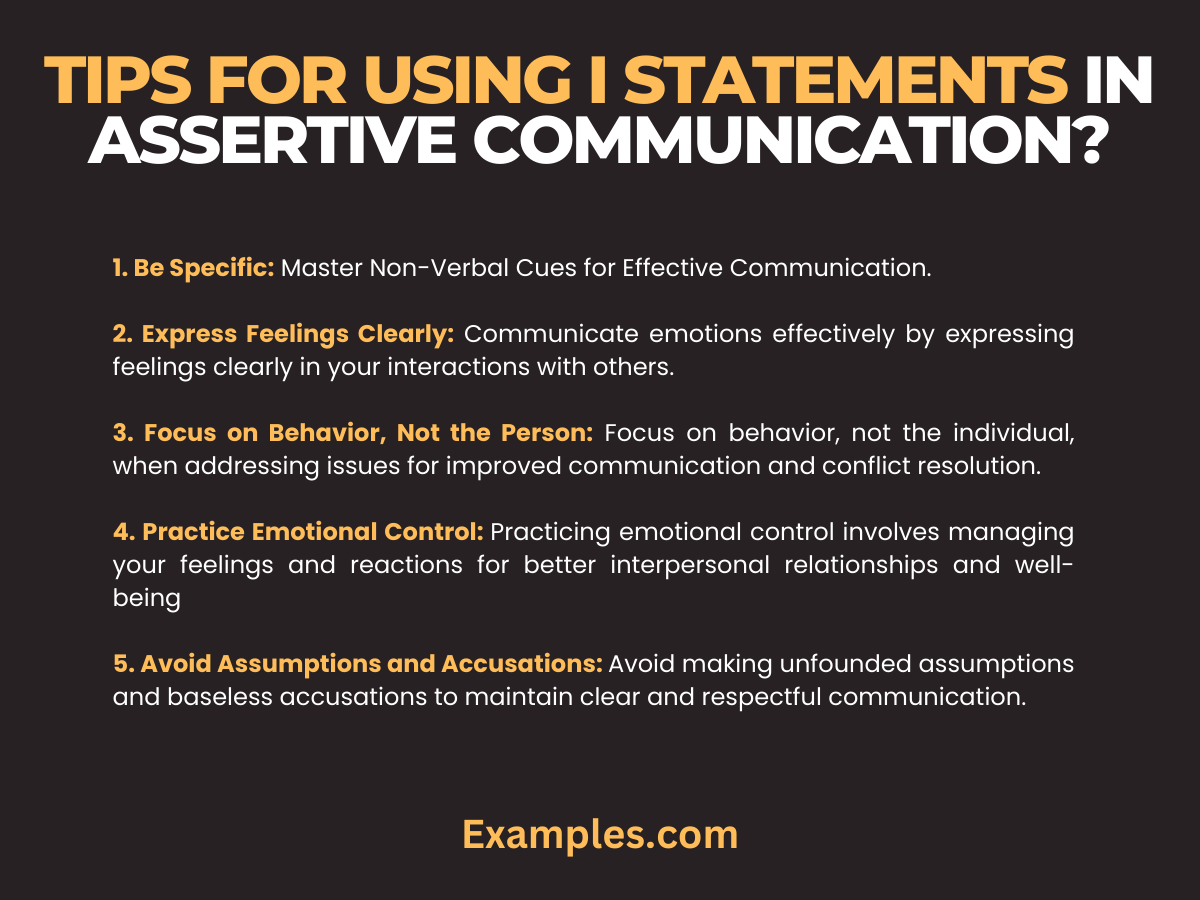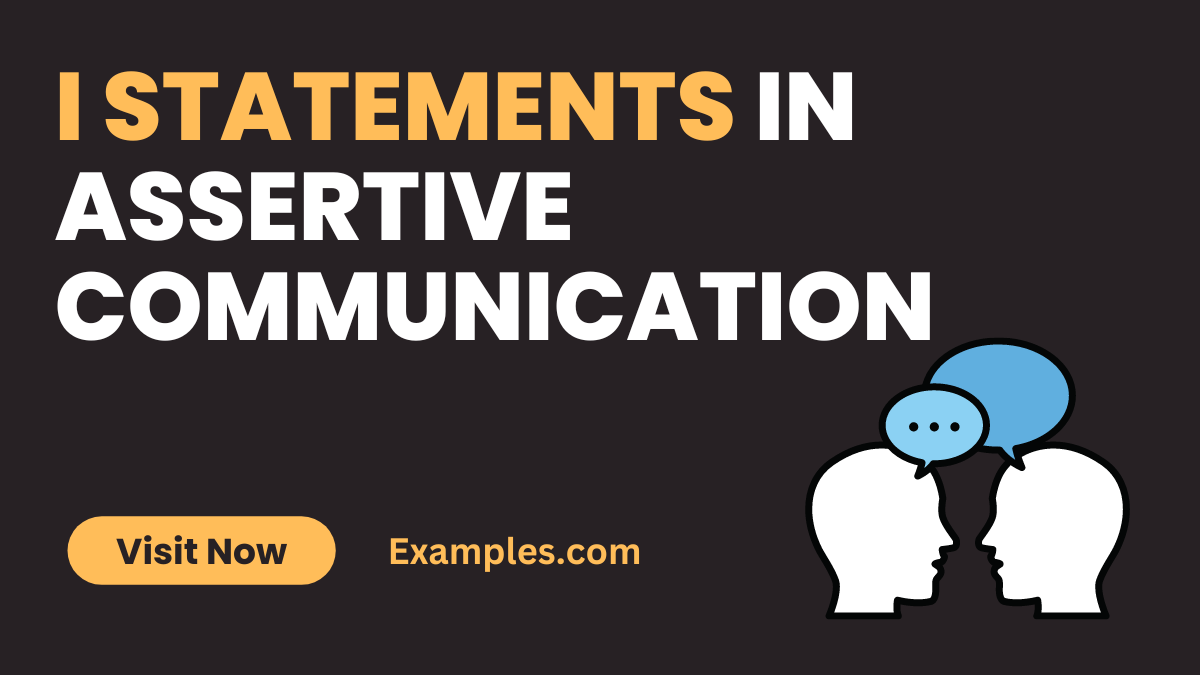29+ I Statements in Assertive Communication Examples
Understanding the role of I Statements in Assertive Communication is crucial for effective interpersonal interactions. These statements empower individuals to express themselves clearly and respectfully, fostering better understanding and reducing conflict. This guide delves into the core principles of using I Statements effectively, offering practical tips and insights for enhancing your communication skills.
What Are I Statements in Assertive Communication?

Assertive Communication Examples and Assertive Communication Skills are essential components of effective interpersonal interaction. I Statements in assertive communication are a powerful tool that allows individuals to express their feelings, needs, and thoughts in a way that is direct yet respectful. This approach helps in reducing misunderstandings and conflicts, promoting a healthy and positive communication environment.
30 Examples of I Statements in Assertive Communication
Assertive communication is a key skill for effective interaction, focusing on expressing one’s thoughts and feelings clearly and respectfully. I statements in assertive communication play a crucial role in this process. They are a powerful tool to express oneself without triggering defensiveness in others. Here are 30 unique and impactful examples of I statements, each with a brief explanation on how to communicate these sentences assertively:
- “I feel concerned when meetings start late, as it impacts our schedule.” Explains personal feelings about a specific situation, requesting a change indirectly.
- “I need some time to think about this before making a decision.” Expresses the need for space and time, maintaining a sense of control.
- “I appreciate your help, but I need to try this on my own first.” Balances gratitude with the desire for independence.
- “I am uncomfortable with this topic, can we discuss something else?” Sets a clear boundary while maintaining respect.
- “I feel unheard when my suggestions are overlooked.” Expresses feelings of neglect in a non-accusatory way.
- “I would prefer if we could find a compromise here.” Shows willingness to work towards a mutual solution.
- “I am not ready to commit to this project yet.” Communicates hesitation without closing the door on future possibilities.
- “I need more information to understand your point of view.” Seeks clarification, emphasizing active listening in assertive communication.
- “I feel valued when my contributions are acknowledged.” Expresses a desire for recognition in a positive way.
- “I disagree with that perspective, but I’m open to discussion.” Shows respectful disagreement and willingness to engage.
- “I am feeling overwhelmed and would appreciate some assistance.” Communicates vulnerability and asks for help directly.
- “I need to set boundaries regarding my workload.” Asserts limits in a professional context.
- “I feel frustrated when deadlines are not met.” Addresses the impact of others’ actions on emotions.
- “I would like to express my opinion on this matter.” Asserts the right to voice thoughts.
- “I am not comfortable with this arrangement.” Expresses discomfort clearly and respectfully.
- “I need to prioritize my health and will be taking a day off.” Places importance on personal well-being.
- “I feel happy when we work collaboratively like this.” Positive reinforcement for desired team behavior.
- “I would appreciate more clarity on this issue.” Requests further explanation in a straightforward manner.
- “I am not sure I agree; can you explain further?” Opens the door for more dialogue while expressing doubt.
- “I need to focus on this task and cannot chat right now.” Sets a clear boundary in a polite way.
- “I feel anxious when we don’t plan ahead.” Shares personal emotions related to team dynamics.
- “I would like to handle this project differently.” Suggests change without undermining current methods.
- “I am committed to finding a solution that works for both of us.” Emphasizes collaboration and mutual benefit.
- “I need your support to complete this successfully.” Expresses dependency in a positive way.
- “I feel relieved when we can talk openly like this.” Encourages open and honest expression in assertive communication.
- “I prefer to discuss this in person rather than over email.” Specifies a preferred communication method.
- “I am not comfortable proceeding without more data.” Asserts the need for evidence before action.
- “I feel respected when my ideas are considered.” Connects feelings of respect to actions of others.
- “I need to understand your expectations more clearly.” Seeks to clarify understanding in a direct manner.
- “I am excited about this opportunity and look forward to contributing.” Expresses enthusiasm and readiness to engage.
How to Use I Statements in Assertive Communication?
Utilizing “I Statements” in assertive communication is a powerful way to express yourself clearly and respectfully. These statements help in conveying your feelings, thoughts, and needs without blaming or criticizing others. Here’s a guide to effectively using I Statements in assertive communication:
- Identify Your Feelings: Start by acknowledging your emotions. Use phrases like “I feel…” to express yourself. This focuses on your feelings rather than placing blame.
- Describe the Situation: Clearly describe the situation causing your reaction without making assumptions. For example, “When I see…” or “When I hear…”
- Express Your Need or Expectation: After stating your feelings, articulate what you need or expect in that situation. Phrases like “I need…” or “I would appreciate…” are effective.
- Use Non-Blaming Language: Ensure your language is non-confrontational. Avoid using accusatory terms like “you always” or “you never.”
- Be Specific and Direct: Vagueness can lead to misunderstandings. Be clear and concise in your statement.
- Maintain a Respectful Tone: Your tone should reflect respect and understanding. This includes both verbal and non-verbal assertiveness in assertive communication.
- Include Positive Feelings: When appropriate, include positive emotions related to the situation or person. This can foster a more receptive environment.
- Practice Active Listening: After expressing your statement, engage in active listening in assertive communication. This shows respect for the other person’s viewpoint and encourages a constructive dialogue.
Tips for Using I Statements in Assertive Communication?

Assertive communication is a key skill that enables individuals to express themselves effectively and stand up for their point of view, while also respecting the rights and beliefs of others. Using “I Statements” is a crucial part of this communication style. Here are eight tips for effectively incorporating I Statements in Assertive Communication:
- Be Specific: Instead of making general statements, be specific about your thoughts, feelings, and needs. For example, say “I feel frustrated when meetings start late” instead of “You are always late to meetings.”
- Express Feelings Clearly: Use “I feel” to express your emotions clearly. This helps in avoiding blame and making the conversation more about your feelings rather than accusing others.
- Focus on Behavior, Not the Person: Address the behavior that affects you, not the person’s character. For instance, “I get confused when instructions are not clear” is more effective than saying, “You are always confusing.”
- Avoid Assumptions and Accusations: Making assumptions can lead to misunderstandings. Use I Statements to express how you interpret a situation and check for understanding. For example, “I assumed that the report was my responsibility, is that correct?”
- Combine with Active Listening in Assertive Communication: After expressing your point of view, engage in active listening. This shows respect for the other person’s perspective and encourages a two-way conversation.
- Use for Positive Feedback as Well: I Statements are not just for negative feedback. Use them to express positive feelings and reinforce good behaviors, such as “I appreciate your help with the project.”
- Practice Emotional Control: Keep your emotions in check. Assertive communication is about expressing your needs calmly and respectfully, even if you feel strong emotions.
- Request Feedback: After sharing your thoughts, encourage the other person to respond. This can be as simple as saying, “I’d like to know how you feel about this.
“I statements” in assertive communication is crucial for effective expression. By using this technique, individuals can convey their thoughts, feelings, and needs assertively and respectfully. Remember to frame statements from your perspective, avoid blame, and focus on your emotions and needs. With practice, “I statements” can enhance relationships and improve communication dynamics, fostering understanding and cooperation.



